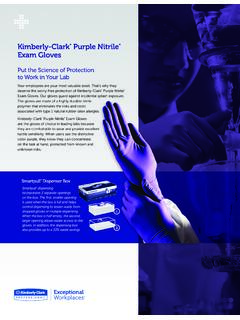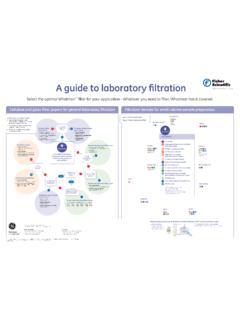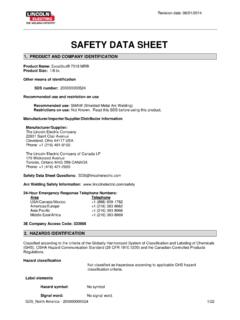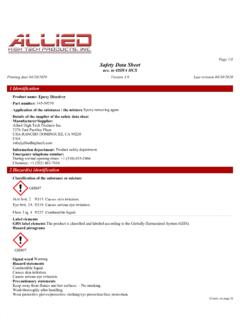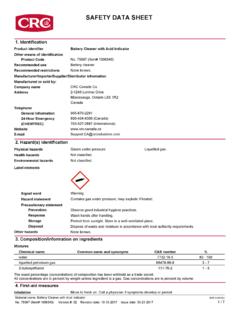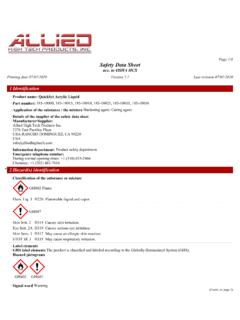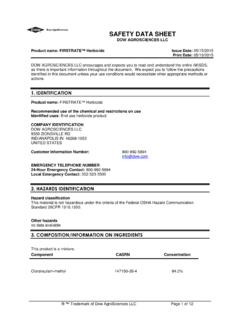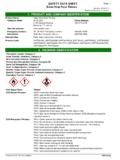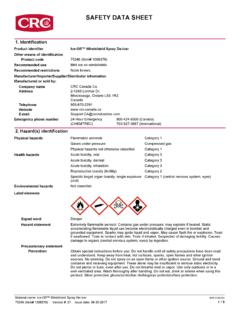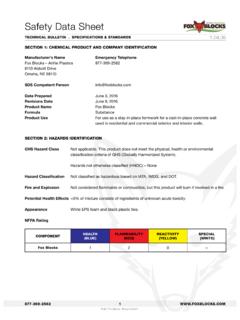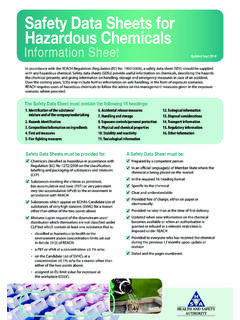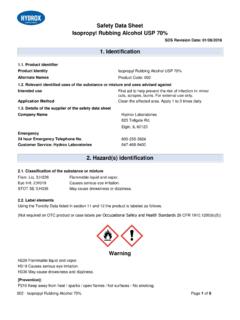Transcription of Safety Data Sheet - Fisher Scientific
1 Safety data Sheetaccording to 29 CFR1910/1200 and GHS Rev. 3 Effective date : 1 of 8 Methanol, Lab Grade, 4 LCreated by Global Safety Management, Inc. -Tel: 1-813-435-5161 - 1 : Identification of the substance/mixture and of the supplierProduct name :Methanol, Lab Grade, 4 LManufacturer/Supplier Trade name:Manufacturer/Supplier Article number:S25426 ARecommended uses of the product and uses restrictions on use:Manufacturer Details:AquaPhoenix Scientific9 Barnhart Drive, Hanover, PA 17331 Supplier Details: Fisher Science Education15 Jet View Drive, Rochester, NY 14624 Emergency telephone number: Fisher Science Education Emergency Telephone No.: 800-535-5053 SECTION 2 : Hazards identificationClassification of the substance or mixture:FlammableFlammable liquids, category 2 ToxicAcute toxicity (oral, dermal, inhalation), category 3 Health hazardSpecific target organ toxicity following single exposure, category 1 AcTox Dermal.
2 3 Flammable liq. 2 AcTox Oral. 3 AcTox Inhaln. 3 Stot SE. 1 Signal word :DangerHazard statements:Highly flammable liquid and vapourToxic if swallowedToxic in contact with skinToxic if inhaledCauses damage to organsPrecautionary statements:If medical advice is needed, have product container or label at handKeep out of reach of childrenRead label before useSafety data Sheetaccording to 29 CFR1910/1200 and GHS Rev. 3 Effective date : 2 of 8 Methanol, Lab Grade, 4 LCreated by Global Safety Management, Inc. -Tel: 1-813-435-5161 - protective gloves/protective clothing/eye protection/face protectionWash skin thoroughly after handlingDo not eat, drink or smoke when using this productAvoid breathing dust/fume/gas/mist/vapours/sprayKeep away from heat/sparks/open flames/hot surfaces. No smokingDo not breathe dust/fume/gas/mist/vapours/spraySpecific treatment (see supplemental first aid instructions on this label)IF ON SKIN: Wash with soap and waterCall a POISON CENTER or doctor/physician if you feel unwellSpecific measures (see supplemental first aid instructions on this label)Take off contaminated clothing and wash before reuseWash contaminated clothing before reuseIF SWALLOWED: Immediately call a POISON CENTER or doctor/physicianIF exposed: Call a POISON CENTER or doctor/physicianIF INHALED: Remove victim to fresh air and keep at rest in a position comfortable for breathingStore locked upStore in a well ventilated place.
3 Keep coolDispose of contents and container as instructed in Section 13 Other Non-GHS Classification:WHMISB2D1BD2 BNFPA/HMISNFPA SCALE (0-4)HMIS RATINGS (0-4)SECTION 3 : Composition/information on ingredientsIngredients:CAS 67-56-1 Methanol>90 % Safety data Sheetaccording to 29 CFR1910/1200 and GHS Rev. 3 Effective date : 3 of 8 Methanol, Lab Grade, 4 LCreated by Global Safety Management, Inc. -Tel: 1-813-435-5161 - are by weightSECTION 4 : First aid measuresDescription of first aid measuresAfter inhalation: Move exposed individual to fresh air. Loosen clothing as necessary and position individual ina comfortable medical breathing is difficult, give oxygenAfter skin contact: Wash affected area with soap and water. Rinse/flush exposed skin gently using water for15-20 minutes. Seek medical attention if irritation persists or if eye contact: Protect unexposed eye. Rinse or flush eye gently with water for at least 15-20 minutes,lifting upper and lower medical attention if irritation persists or if concernedAfter swallowing: Rinse mouth thoroughly.
4 Do not induce vomiting. Have exposed individual drink sips ofwater. Dilute mouth with water or milk after medical important symptoms and effects, both acute and delayed:Poison. Toxic by ingestion, absorption through skin and inhalation, potentially causing irreversible to eyes, skin, and respiratory tract. Irritation- all routes of be fatal or cause blindness if swallowed. Cannot be made non-poisonous. Maycause gastrointestinal irritation, vomiting, and diarrhea. Central nervous system disorders. Skin disorders,preexisting eye disorders, gastrointestinal tract;Toxic: danger of very serious irreversible effects by inhalation,ingestion or absorption through skin. Experiments have shown reproductive toxicity effects on laboratoryanimals. May cause adverse kidney and liver effectsIndication of any immediate medical attention and special treatment needed:If seeking medical attention, provide SDS document to should treat 5 : Firefighting measuresExtinguishing mediaSuitable extinguishing agents: Dry chemical, foam, dry sand, or Carbon spray can keepcontainers Safety reasons unsuitable extinguishing agents: Water may be hazards arising from the substance or mixture:Risk of ignition.
5 Vapors may form explosive mixtures with air. Vapors may travel to source of ignition and flashback. Containers may explode when heatedAdvice for firefighters:Protective equipment: Wear protective eyeware, gloves, and clothing. Refer to Section information (precautions): Remove all sources of ignition. Avoid contact with skin, eyes, adequate precautions against static 6 : Accidental release measuresPersonal precautions, protective equipment and emergency procedures:Use spark-proof tools and explosion-proof exhaust ventilation or other engineering controlsto keep the airborne concentrations of vapor and mists below the applicable workplace exposure limits(Occupational Exposure Limits-OELs) indicated adequate precautions:Prevent from reaching drains, sewer or waterway. Should not be released into and material for containment and cleaning up:If necessary use trained response staff or contractor.
6 Remove all sources of ignition. Contain spillage and thenSafety data Sheetaccording to 29 CFR1910/1200 and GHS Rev. 3 Effective date : 4 of 8 Methanol, Lab Grade, 4 LCreated by Global Safety Management, Inc. -Tel: 1-813-435-5161 - Do not flush to with a noncombustible absorbent material such as sand or earth andcontainerize for disposal. Ventilate area of leak or spark-proof tools and proper disposal methods. Refer to Section to other sections:SECTION 7 : Handling and storagePrecautions for safe handling:Use in a chemical fume hood. Wash hands before breaks and immediately after handling the with skin, eyes, and precautions against static for safe storage, including any incompatibilities:Store in a cool location. Provide ventilation for containers. Avoid storage near extreme heat, ignition sources oropen flame. Keep container tightly with like hazards. Protect from freezing and physical 8 : Exposure controls/personal protectionControl Parameters:67-56-1, Methanol, ACGIH: 250 ppm STEL; 200 ppm TWA67-56-1, Methanol, NIOSH: 250 ppm STEL; 325 mg/m3 STEL67-56-1, Methanol, NIOSH: 200 ppm TWA; 260 mg/m3 TWAA ppropriate Engineering controls:Emergency eye wash fountains and Safety showers should be available inthe immediate vicinity of use or handling.
7 Ensure that dust-handlingsystems (exhaust ducts, dust collectors, vessels, and processingequipment) are designed to prevent the escape of dust into the protection:Use in a chemical fume hood. If exposure limit is exceeded, a full-facerespirator with organic cartridge may be of skin:Select glove material impermeable and resistant to the material based on rates of diffusion and protection: Safety glasses with side shields or hygienic measures:Wash hands before breaks and at the end of work. Avoid contact with theeyes and of contaminated gloves after use in accordancewith applicable laws and good laboratory 9 : Physical and chemical propertiesAppearance (physicalstate,color):Clear colorless liquidExplosion limit lower:Explosion limit upper:631 Odor:AlcoholVapor pressure:128 hPa @ 20 COdor threshold:Not AvailableVapor :Not AvailableRelative point:-98 CSolubilities:Miscible at 20 CSafety data Sheetaccording to 29 CFR1910/1200 and GHS Rev.
8 3 Effective date : 5 of 8 Methanol, Lab Grade, 4 LCreated by Global Safety Management, Inc. -Tel: 1-813-435-5161 - point/ C @ 760mmHgPartition coefficient (n-octanol/water):Not AvailableFlash point (closedcup):12 CAuto/Self-ignitiontemperature:455 CEvaporation :Not AvailableFlammability(solid,gaseous):Fla mmableViscosity:a. Kinematic:Not Availableb. Dynamic: Not AvailableDensity: Not AvailableSECTION 10 : Stability and reactivityReactivity:Vapours may form explosive mixture with stability:Stable under normal hazardous reactions:None under normal to avoid:Excess heat, Incompatible Materials, flames, or materials: Oxidizing agents, reducing agents, alkali metals, acids, sodium, potassium, metals aspowders, acid chlorides, acid anhydrides, powdered magnesium, and decomposition products:carbon monoxide, 11 : Toxicological informationAcute Toxicity:Dermal:(rabbit)LD-50 15800 mg/kgOral:(rat)LD-50 5628 mg/kgInhalation:(rat)LC-50 130,7 mg/lChronic Toxicity: No additional Irritation:Ocular:Irritating to eyesDermal:Irritating to skinSensitization:No additional Target Organ (STOT):Classified as causing damage toorgans.
9 Eyes, skin, optic nerve,gastrointestinal tract, central nervoussystem, respiratory system, liver, spleen,kidney, bloodNumerical Measures:No additional :Teratogenicity : has occurred inexperimental :Mutagenetic effects have occurred inexperimental data Sheetaccording to 29 CFR1910/1200 and GHS Rev. 3 Effective date : 6 of 8 Methanol, Lab Grade, 4 LCreated by Global Safety Management, Inc. -Tel: 1-813-435-5161 - Toxicity:Developmental Effects(Immediate/Delayed) have occurred inexperimental animalsSECTION 12 : Ecological informationEcotoxicityFreshwater Fish: 96 Hr LC50 Pimephales promelas: 28200 mg/LFreshwater Fish: 96 Hr LC50 Oncorhynchus mykiss: 19500 - 20700 mg/LFreshwater Fish: 96 Hr LC50 Pimephales promelas: >100 mg/LFreshwater Fish: 96 Hr LC50 Oncorhynchus mykiss: 18 - 20 mL/LFreshwater Fish: 96 Hr LC50 Lepomis macrochirus: 13500 - 17600 mg/LPersistence and degradability: Not potential: Not in soil: Aqueous solution has high mobility in adverse effects:SECTION 13 : Disposal considerationsWaste disposal recommendations:Methanol RCRA waste code U154.
10 Do not allow product to reach sewage system or open is theresponsibility of the waste generator to properly characterize all waste materials according to applicableregulatory entities (US ). Absorb with a noncombustible absorbent material such as sand or earthand containerize for disposal. Provide ventilation. Have fire extinguishing agent available in case of all sources of spark-proof tools and explosion-proof wastegenerators must determine whether a discarded chemical is classified as a hazardous waste. Chemical wastegenerators must also consult local, regional, and national hazardous waste regulations. Ensure complete andaccurate 14 : Transport informationUN-NumberUN1230UN proper shipping nameMethanolTransport hazard class(es)Class:3 Flammable Toxic substancesPacking group:IIEnvironmental hazard:Transport in bulk:Special precautions for user:SECTION 15 : Regulatory informationSafety data Sheetaccording to 29 CFR1910/1200 and GHS Rev.


